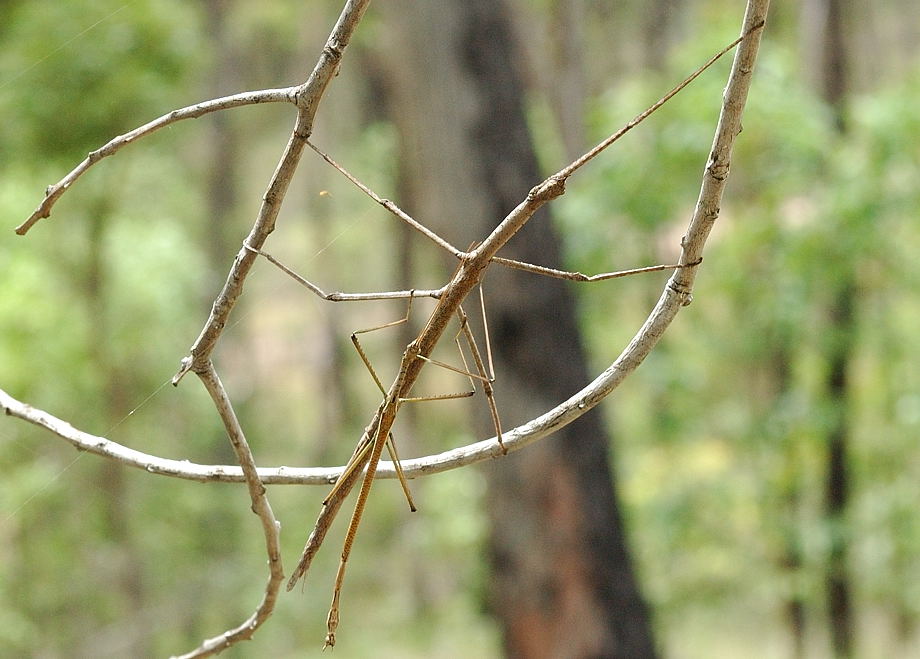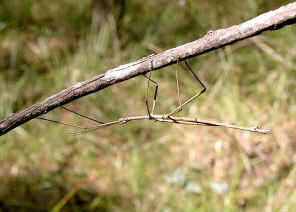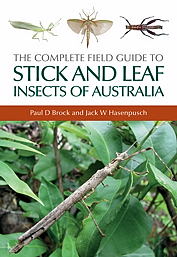|
|
Stick and Leaf Insects - Order Phasmatodea
This page contains pictures and information about Stick Insects and Leaf Insects that we have found in the Brisbane area, Queensland, Australia.

The stick insects are also commonly known as Walking Sticks. The insects within this order are large to very large. This order includes the stick insects and leaf insects. They tend to resemble sticks, twigs or leaves. Usually they are green or brown in colour. They spend much of their time hanging motionless in plants, shrubs or trees. Even if they move, they sway slightly, as if caught by the movement of the wind. They are not easily seen for their camouflage. Stick insects have powerful mandibles. They are herbivorous, they eat plant leaves only, usually feed on broad-leaved plants. In general, females are much larger than males. The male can fly, but the female can only glide. Stick insects prefer a humid environment, remember to mist the leaves constantly with a spray bottle if you keep them.
- The stick insect egg or ova has a very characteristic form. It has a very hard and tough shell. There is a cap at one end, called a capitulum, which the baby insect pushes off when it comes out of the egg case. In general, most stick insect eggs look like seeds. Some ants will even pick them up and keep them as if they are real seeds. Most stick insects just drop their eggs onto the ground.



- Eggs of Children's Stick Insect 1st instars of unknown stick insect species. Male Tessellated Stick-insect
- The stick insects will undergo various moulting stages. After each moult, they will usually eat their shedded skin, as this contains protein. They are amongst a small number of insects that can regenerate lost appendages. Usually they are active at night. During the day they lay still on on the tree or shrub.
Classification :
There are two families of Stick Insects, Phylliidae and Phasmatidae, in Australia. Most stick insects we found are in family Phasmatidae, only two in Phylliidae.
Questions for Discussion
Stick Insects are the master of camouflage, what can we notice about their camouflage? How do they defence themselves against their predators?
- We notice that Stick Insects have at least the following methods to hide themselves from predators;
1. Their body shapes and colours make them look like part of the plants that they live on.
2. When staying motionless, they always put their front legs in front of their head, making them look like part of the plant, branch or twig.
3. They usually feed at night, during the day time they just remain motionless on the plant.
4. They usually eat the whole leaf, not leaving any uneaten leaves with bite marks, like grasshoppers do.
5. Even when the move, they sway from side to side, as if blown by the wind.
6. Their eggs look like seeds, so the predator do not notice them.
7. The Goliath Stick Insect scatter their droppings at a distance so that the predators do not see them.
8. When disturbed, they sometimes may just drop to the ground and play dead, this act is called catalepsy.- 9. After each moult, stick insects usually eat their shedded skin as this contains proteins, and also helps prevent the predators from also eating or noticing the insect.
By watching the stick insects, we notice that they has at least the following defence mechanisms. Of course their primary mechanism are their heavily camouflage. Their appearances and movement resemblance to leaves so that they can hind away from predators. Their second defence mechanism is to scare theirs predators. When disturbed, some stick insects, such as the Goliath Stick Insect, will display the bright red colour under its wings and the eyes-pattern between the thorax and hind legs, together with swishing sound apparently coming from the wings. Its will also kick its spiny legs which will help frighten the predator. We also noticed that some stick insects that we found, some of their legs are missing, or some legs are a little bit smaller than normal. This could be its last defence mechanism, when its legs held by its predator, e.g. a bird, it loses its leg deliberately and drop to the ground, the bird may not find it for its heavily camouflage.
We also notice that the number of stick insects is very low when comparing with other insects, such as grasshoppers, which they live in similar habitat. It seems that nothing stop the grow of the population of stick insects. So we gauss being rare is another survival factors of stick insects. The predators cannot depend on stick insects as a constant food source and have less chance to learn how to recognize the stick insects. Being rare is a way of camouflage.
Stick Insects are heavily camouflage, how do they find their mate for reproduction?

-
Most insects have their special ways for finding their mate for reproduction. To name a few, the butterflies and dragonflies have very good eye sight, so they attract their mates by colours and patterns. The crickets and cicadas sing their love songs. The moths use their sense of smell. The ants have their mating flight while some butterflies have gathering on the hill top. For Stick Insects, it seems that they do not have any special methods to find their mates. They have poor eye sight as well as heavily camouflage, so it is not easy for them to 'look' for their mates. They do not produce any love songs, their antenna is not well developed as moths to smell their mates. They do not have special gathering event like ants of butterflies. How do Stick Insects find their mate? This seem the job of the male stick insect, because usually only the male can fly. How do the males locate a female?
In most stick insect species, females are much larger than males in size. However, males' antenna are always longer than females'. This give a clue that female stick insects probably attract males by pheromones.
In 1996 newspaper, Australian Museum naturalist Dr. Andrew Parker discovered that Spiny Stick Insect Extatosoma tiaratum reflect ultraviolet light to attract male.
For a frog species in the desert, because it is very difficult to find a mate, if a male frog meet a female frog, even not in the mating season, the male will hold itself on the back of the female frog until mating season. We saw some male stick insects doing the same thing. Its seem that the stick insect employ the same method as the desert frogs.
I read form books that some stick insect species can breed
parthenogentically, i.e., reproduce by female without
mating. The eggs will hatch without fertilized by males. Surprisingly, the
unfertilized eggs produce both males and females (this contradicts with my
knowledge of chromosomes reproduction). This could be a
evolution solution that temporally fix this problem.
- Here we would like to thank Paul D. Brock for his kindly advises on our Stick Insects Pages. More about Paul can be found on his book THE AMAZING WORLD OF STICK AND LEAF-INSECTS and his new book The Complete Field Guide to Stick and Leaf Insects of Australia.
- Reference:
- 1. Order PHASMATODEA Stick Insects - Australian Biological Resources Study, Australian Faunal Directory, 1997.




